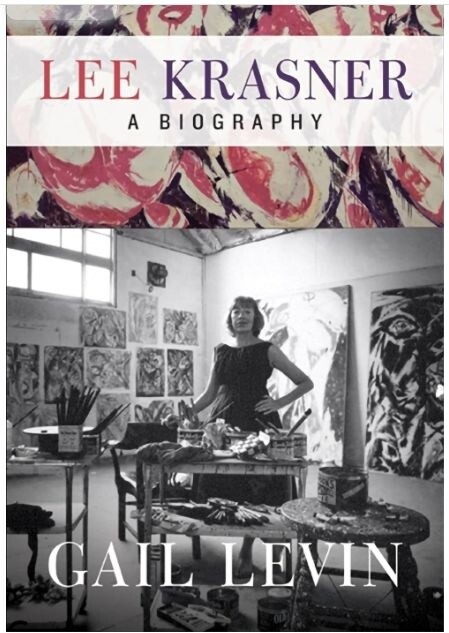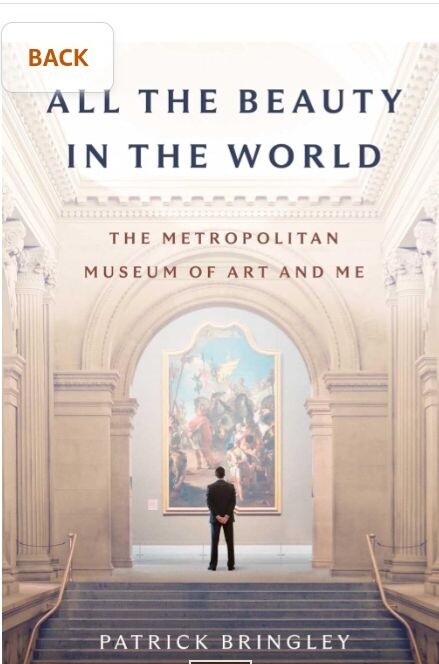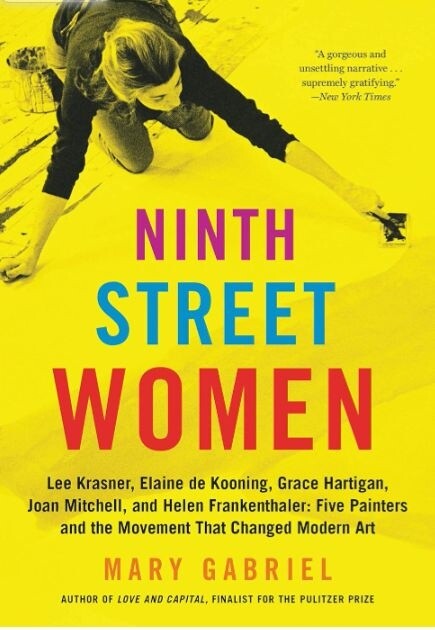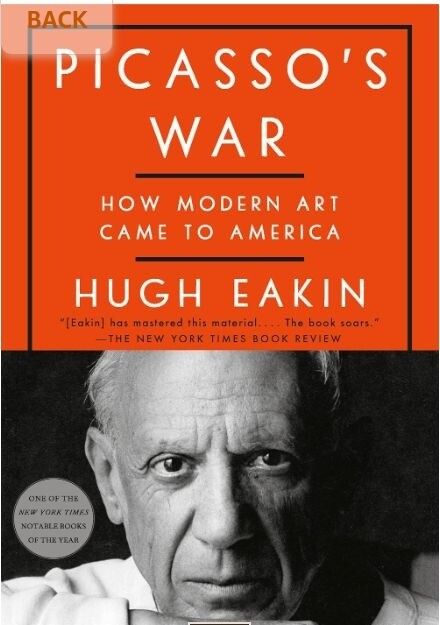Sunshine Amos
Art books I Read In A Week

About The Book:
Perhaps best known as the long-suffering wife of Jackson Pollock, Lee Krasner is now, finally, being recognized as one of the 20th century’s modernist masters. In Lee Krasner, author Gail Levin gives us an engrossing biography of the painter—so memorably portrayed in the movie Pollack by actor Marcia Gay Harden, who won an Academy Award for her performance—a firebrand and trailblazer for women’s rights as well as an exceptional artist who led a truly fascinating life.

ABOUT The Book
best book of the year from New York Public Library, NPR, the Financial Times, Book Riot, and the Sunday Times (London).
A fascinating, revelatory portrait of the Metropolitan Museum of Art and its treasures by a former New Yorker staffer who spent a decade as a museum guard.
Millions of people climb the grand marble staircase to visit the Metropolitan Museum of Art every year. But only a select few have unrestricted access to every nook and cranny. They’re the guards who roam unobtrusively in dark blue suits, keeping a watchful eye on the two million square foot treasure house. Caught up in his glamorous fledgling career at The New Yorker, Patrick Bringley never thought he’d be one of them. Then his older brother was diagnosed with fatal cancer and he found himself needing to escape the mundane clamor of daily life. So he quit The New Yorker and sought solace in the most beautiful place he knew.
To his surprise and the reader’s delight, this temporary refuge becomes Bringley’s home away from home for a decade. We follow him as he guards delicate treasures from Egypt to Rome, strolls the labyrinths beneath the galleries, wears out nine pairs of company shoes, and marvels at the beautiful works in his care. Bringley enters the museum as a ghost, silent and almost invisible, but soon finds his voice and his tribe: the artworks and their creators and the lively subculture of museum guards—a gorgeous mosaic of artists, musicians, blue-collar stalwarts, immigrants, cutups, and dreamers. As his bonds with his colleagues and the art grow, he comes to understand how fortunate he is to be walled off in this little world, and how much it resembles the best aspects of the larger world to which he gradually, gratefully returns.
In the tradition of classic workplace memoirs like Lab Girl and Working Stiff, All The Beauty in the World is a surprising, inspiring portrait of a great museum, its hidden treasures, and the people who make it tick, by one of its most intimate observers.

ABOUT The Book
Five women revolutionize the modern art world in postwar America in this "gratifying, generous, and lush" true story from a National Book Award and Pulitzer Prize finalist (Jennifer Szalai, New York Times).
Set amid the most turbulent social and political period of modern times, Ninth Street Women is the impassioned, wild, sometimes tragic, always exhilarating chronicle of five women who dared to enter the male-dominated world of twentieth-century abstract painting -- not as muses but as artists. From their cold-water lofts, where they worked, drank, fought, and loved, these pioneers burst open the door to the art world for themselves and countless others to come.
Gutsy and indomitable, Lee Krasner was a hell-raising leader among artists long before she became part of the modern art world's first celebrity couple by marrying Jackson Pollock. Elaine de Kooning, whose brilliant mind and peerless charm made her the emotional center of the New York School, used her work and words to build a bridge between the avant-garde and a public that scorned abstract art as a hoax. Grace Hartigan fearlessly abandoned life as a New Jersey housewife and mother to achieve stardom as one of the boldest painters of her generation. Joan Mitchell, whose notoriously tough exterior shielded a vulnerable artist within, escaped a privileged but emotionally damaging Chicago childhood to translate her fierce vision into magnificent canvases. And Helen Frankenthaler, the beautiful daughter of a prominent New York family, chose the difficult path of the creative life.
Her gamble paid off: At twenty-three she created a work so original it launched a new school of painting. These women changed American art and society, tearing up the prevailing social code and replacing it with a doctrine of liberation. In Ninth Street Women, acclaimed author Mary Gabriel tells a remarkable and inspiring story of the power of art and artists in shaping not just postwar America but the future.

ABOUT The Book
How do art and faith intersect? How does art help us see our own lives more clearly? What can we understand about God and humanity by looking at the lives of artists?
Striving for beauty, art also reveals what is broken. It presents us with the tremendous struggles and longings common to the human experience. And it says a lot about our Creator too. Great works of art can speak to the soul in a unique way.
Rembrandt Is in the Wind is an invitation to discover some of the world's most celebrated artists and works and how each of them illuminates something about God, people, and the purpose of life. Part art history, part biblical study, part philosophy, and part analysis of the human experience, this book is nonetheless all story.
From Michelangelo to Vincent van Gogh to Edward Hopper, the lives of the artists in this book illustrate the struggle of living in this world and point to the beauty of the redemption available to us in Christ. Each story is different. Some conclude with resounding triumph while others end in struggle. But all of them raise important questions about humanity's hunger and capacity for glory, and all of them teach us to love and see beauty.
"The artists featured in these pages—artists who devoted their lives and work to what is good, true, and beautiful—remind us that we can, and should, do the same." —Karen Swallow Prior, author of On Reading Well.

ABOUT The Book:
A riveting story of how dueling ambitions and the power of prodigy made America the cultural center of the world—and Picasso the most famous artist alive—in the shadow of World War II
“[Eakin] has mastered this material. . . . The book soars.”—The New York Times Book Review (Editors’ Choice)
ONE OF THE BEST BOOKS OF THE YEAR: Vanity Fair, The New York Times Book Review, The New Yorker
In January 1939, Pablo Picasso was renowned in Europe but disdained by many in the United States. One year later, Americans across the country were clamoring to see his art. How did the controversial leader of the Paris avant-garde break through to the heart of American culture?
The answer begins a generation earlier, when a renegade Irish American lawyer named John Quinn set out to build the greatest collection of Picassos in existence. His dream of a museum to house them died with him, until it was rediscovered by Alfred H. Barr, Jr., a cultural visionary who, at the age of twenty-seven, became the director of New York’s new Museum of Modern Art.
Barr and Quinn’s shared goal would be thwarted in the years to come—by popular hostility, by the Depression, by Parisian intrigues, and by Picasso himself. It would take Hitler’s campaign against Jews and modern art, and Barr’s fraught alliance with Paul Rosenberg, Picasso’s persecuted dealer, to get Picasso’s most important paintings out of Europe. Mounted in the shadow of war, the groundbreaking exhibition Picasso: Forty Years of His Art would launch Picasso in America, define MoMA as we know it, and shift the focus of the art world from Paris to New York.
Picasso’s War is the never-before-told story about how a single exhibition, a decade in the making, irrevocably changed American taste, and in doing so saved dozens of the twentieth century’s most enduring artworks from the Nazis. Through a deft combination of new scholarship and vivid storytelling, Hugh Eakin shows how two men and their obsession with Picasso changed the art world forever.

